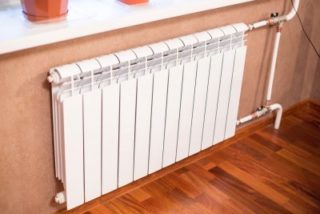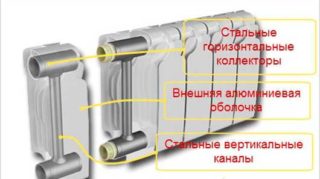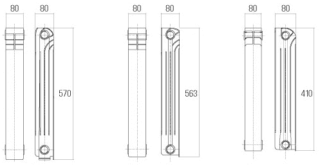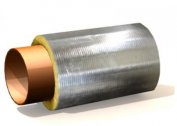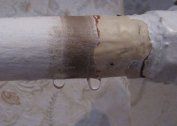Bimetal radiators are not made from one, but from two dissimilar metals. These products first appeared on European markets more than 50 years ago. They quickly won the recognition of the general public, due to their high quality indicators and reliable operation in existing heating systems.
The device of bimetallic radiators
The main difference between bimetallic batteries and analogues that are homogeneous in composition is that inside them there is a stainless steel case, over which aluminum fins are located. This design eliminates the direct contact of reactive aluminum with a liquid medium. The steel base is more resistant to destructive effects, which increases the life of heating batteries. According to manufacturers, for some models this figure reaches 20 years.
The presence of a steel casing provides increased structural strength. The operating pressure of bimetallic radiators can reach 40 atmospheres. Due to this, such products easily tolerate water hammer, which often happens in heating systems. Features of the internal device with a complex relief of the channels for the coolant allow you to get the optimal combination of its daily flow rate and thermal inertness. The original design of bimetallic devices is added to the features.
Bimetal Benefits
The advantages of bimetallic radiators include:
- long terms of operation;
- good strength indicators;
- increased heat transfer and efficient heating of large areas of space;
- resistance to corrosion damage;
- short reaction time to thermostat response;
- attractive appearance.
The aluminum frame of the radiators fits perfectly into the interiors of modern rooms, the breakdown into collapsible sections allows you to choose the desired dimensions and power rating.
Options for manufacturing radiators
Bimetal structures are available in the following two versions:
- pseudo-bimetallic products;
- pure bimetal.
In the first of these options, the steel core is present only in some areas within the vertical channels. In these devices, aluminum is not completely protected from the effects of the aggressive environment, but only in the weakest places. Such models cost a little cheaper, the average service life is about 10 years.
Purely bimetallic products have a one-piece steel casing, on top of which is filled with aluminum alloy in high pressure mode. In such models, the degree of protection is much higher, they cost more, their service life, ceteris paribus, reaches 30 years. In accordance with the installation features, radiators of this class are divided into collapsible and non-collapsible.
The first are disassembled using a conventional radiator key. With its help, it is possible to add one or more sections to them or vice versa - to dismantle them. They are installed in private houses with autonomous heating systems, where the developed pressure is low. Non-separable radiators are made in the form of a monolith, which cannot be built up or attached to another product.These samples are used in urban apartments, which are characterized by increased pressure in the heating network.
Sizes of bimetallic batteries
When assessing the size of bimetallic radiators, the place of their installation and continuous operation should be taken into account. When placed in niches under the windows in a house or apartment, the selected battery must guarantee reliable protection against cold air entering through low-quality seals. Bimetal heaters manufactured by industry have typical sizes.
The distances between the vertical jumpers of the heater are 200, 350 or 500 mm, depending on the specific model. These numbers correspond to the center distance between the inlet and outlet radiator pipes. To determine the exact value of the specified parameter, add 40 mm on each side. In this case, with a center distance of 500 mm, for example, the total dimension will be 580 mm. The width of the entire radiator product depends on the total number of installed sections.
Selection recommendations

When choosing bipolar radiators, the main attention is paid to the declared technical characteristics and design features, when familiarizing with which the following points are taken into account:
- Monolithic products withstand pressures up to 100 atmospheres and are suitable for dwellings in which hydraulic shocks are often observed. Due to the high cost of monolithic structures in all other cases, it is recommended to choose sectional models.
- The number of sections is selected based on the required level of heating the room.
- With equal opportunities for different models, they differ in the distance between the collector axes. This indicator can have both standard values (50 and 35 centimeters), and atypical.
Radiators of small height of 20 cm are not produced by all manufacturers. Large values of this indicator (about 80 cm) are found only in models manufactured by the Italian company Sira.
Verified Bimetal Radiator Manufacturers
The characteristics of bimetallic radiators declared by the manufacturer determine the user demand for these models. Products on an all-steel frame are manufactured by the following companies:
- Italian manufacturer Global Style;
- Royal Thermo BiLiner from Italy;
- Russian Santechprom BM.
The presented list includes the Russian company Rifar. The MonoliВ model produced by it has only a partially metal frame, due to which the thermal efficiency is increased. In addition, its cost is about 20 percent lower than the same indicator for products with an all-steel frame.
The three most popular manufacturers of bimetal models:
- Russian company Rifar;
- Italian Sira;
- Chinese Gordi.
Verified manufacturers do not cause the buyer even the slightest doubt.
